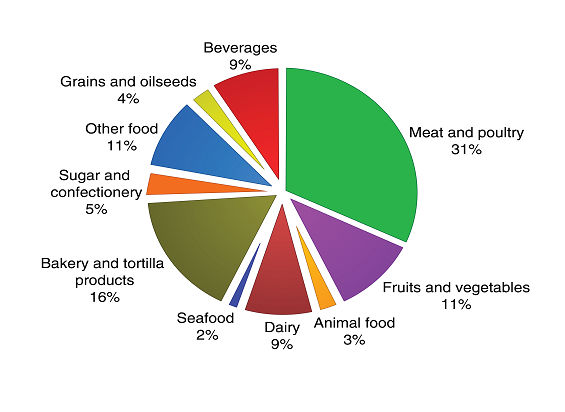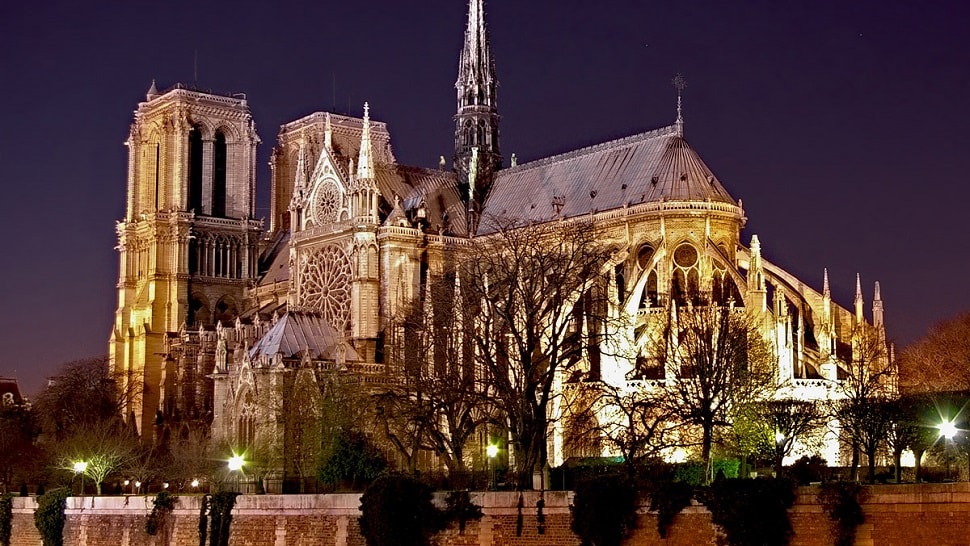Theme: Innovating new technologies in the field of food processing and technology
Food Tech Expo 2019
We’re proud to announce the commencement of the European Food technology and Processing Congress, which is to be held during November 04-05, 2019 at Paris, France. This Food processing assembly highlights the theme “Innovating new technologies in the field of food processing and technology ".
European Food Tech Expo 2019 conference is aimed to provide an opportunity for professionals to discuss the technological advancements in the field of Food processing and Technology. Food technology Congress is designed to provide a platform for Food technologist, Microbiologist, Food safety officers, Nutritionists, Dietician, Quality control officers, Quality assurance officers, Scientists, Researchers, Biotechnologists, Industrialists, Food Engineers, Food Professional from Manufacturing, Retail and Food Service Industry, Food Auditor and Nutrition Trainer or Consultant, Owner or Manager of Food Business, Chef or Food & Beverage Manager working in Food Service Sector, Food Trader or Exhibitor, Food Importer, Exporter or Nutrition Supplements, Government Food and Nutrition Control or Health Official, Member of the Academia, Research Scholar, Representative of a Consumer Group and students working in the field of Food Processing to deliberately exchange views and their experiences in front of international professionals working in the same field. In this International conference on Food technology, we welcome CEO’s, Business delegates, Young researchers and talented understudy bunches from universities in the sector of Food technology & Processing, Delegates and industrial executives from Food Processing and nutritional industries to participate in the interactive scientific-sessions, B2B meetings and panel discussions.
Why attend?
Researchers from around the world are focused on learning about Food Technology, processing and its advancement so this is your best opportunity to reach the largest assembly of participants of the Food Technology and Processing community. This conference seek to bring scientists, researchers, research scholars, students and people together who are involved in Food Technology and Processing field and provide them to discuss their innovations, sharing ideas and interaction. Renowned speakers, the most recent development and advancement in the field of food technology are the limelight of the conference.
Food packaging prevents contamination and allows food to be transported easily. It also and extends the shelf life depending on the type of packaging. Even in food packaging, many concerns are raised that the chemicals which are used to pack the food products migrate into the food, thus raising the health issues due to the certain product.
The food packaging also has labeling with information about the contents, ingredients, nutritional content, cooking instructions and shelf life of the food. The packaging needs to be designed such that there is little to no interaction between the food and packaging.
Food processing is a technology which uses a set of techniques and methods to transform raw ingredients (or raw Food) into other forms for consumption by humans or animals by the food processing industry. Food processing typically takes harvested crops or animal products and produces marketable, long-life products which can be consumed directly or stored to cook later.
The main benefits of food processing are preservation, distribution, marketing, protection from environmental substances and the ease of preparation.
There are also a few drawbacks of food processing like the loss of nutritional value and health effects due to added additives.
Some of the Food processing methods are:
Removing the outer layer of vegetables.
Chopping or slicing of vegetables.
Mincing.
Liquefaction (to produce fruit juice).
Fermentation in beer.
Mixing.
Addition of air for bread packaging or gasification of soft drinks.
Packaging.
Food microbiology refers to the study of micro-organisms that contaminate or destroy food.
Food Microbiology mainly focuses on a variety of research on bacteria that have beneficial as well as harmful effects on the quality of food.
Food-borne micro-organisms interact differently with various foods and their response differs with various food products.
So there is a need to study the microbial diversity for improving the quality, safety, and to maintain healthy properties of processed foods.
Packaging plays a major role in the Food industry.
Everything including the convenience, attractiveness, and shelf-life are taken care by proper packaging of Food.
This track of the Food Processing congress includes the advancement in the machinery used to process the food, portion in respected size and pack.
Even the food packaging industry equipment must meet the federal Regulatory standards for safety, electrical code, sanitation, etc. Also the Packaging depends on the demand for capacity, speed, accuracy, waste reduction, durability and ease of use.
The different types of Food processing include:
Thermo-Processing
Frozen Food Processing
Grain processing
Poultry and Meat Processing
Baby Food processing
Some Emerging Technologies
- Hurdle technology
- Thermal processing technology
- Non-thermal processing
- Extrusion and drying
Food borne and Nutritional Disorders
Nutritious food is basic necessity of life for human beings. If we fail to obtain sufficient micronutrients (vitamins, minerals) our health will deteriorate. While we already know that malnutrition and hunger are the main problems in developing world, proper nutritious food can solve the problem of under-nutrition.
Food can also become a source of foodborne illness which can result from eating contaminated food, spoiled food or food with toxic substances.
Climate change also plays a major role in the nutritional quality, security and quality of food.
Main causes include:
- Increase in the usage of agricultural chemicals due to increase in pests
- Maintenance of food supply during extreme weather conditions
- Climate change due to increase in floods and drought
Food fermentation refers to the process which converts carbohydrates to alcohol using microorganisms like yeast.
Food fermentation also refers to the chemical conversion of sugar into ethanol. The similar process takes place in making of bread and preservation of yogurt, storage of olive and cheese.
Food machinery consists of various types of machines used in packaging, heating, cooking, chopping and mixing.
Depending on the type of food, it is packed in numerous ways. Different types of packaging machines are used to pack different food products depending on the storage life of the product. Example: meat and frozen items are kept in vacuum sealed packages to extend their storage life.
- · Bundling Food Packaging Equipment
- · Food Vacuum Packaging Machine
- · Biscuit Packaging Machine
- · Bagging, Closing and Capping Machine
During the quality management program, all food products go through investigation process. The food products are tested throughout the development, production and even after launching in the market.
The food analysis is done by taking physical, chemical and biological attributes of food and drinks.
- · Nutritional Labelling
- · Hazard Analysis
- · Food Inspection
- · Food manufacturing practices
Packaging plays a major role in the beverage industry. Juice packaging is necessary for increasing
1. Shelf life
2. Convenience
3. Sustainability
In the beverage Packaging industry, the major components include rigid plastics, Flexible plastics, Metal, Glass, Tetra packs and Labels which are packed in various types like a bottle, can, pouch, cartons, and others.
Talking about the beverage packing industry, the size of the market was estimated at USD 117.0 billion in 2016 and is expected to reach a value of USD 142.28 billion by 2023 at a CAGR of 4.17%, over the forecast period (2018-2023).
Packaging industry also has to constantly find innovative ways to reduce the weight of the bottle. Many manufacturers are making efforts to reduce the weight of the existing material or switch to lighter pack format.
Seafood processing refers to the process in which fish products are processed form the time they are caught to the time it is delivered to the customer. The term seafood refers to all the aquatic organisms which are harvested for commercial use, whether they are caught in rivers, lakes, or grown during fish farming or harvested from aquaculture.
Seafood processing is divided into raw fish handling, manufacture of fish products, freezing of fish for distribution, producing frozen and canned fish products.
Food flavouring (or food flavoring) refers to the blending of essences, liquid extracts and flavours which are added to the produce to enhance the taste and aroma.
Essential oils from fruits and vegetables, synthetic organic chemicals, food colouring is the basic flavourings which are used.
Although the food flavouring industry mainly used to focus on natural flavouring substances, today we see a lot of organic chemical components such as alcohol, hydrocarbons and phenol ethers used.
Classification of food flavours:
- · Natural Flavours like herbs, fruits, spices and aromatic seeds like cumin.
- · Processed flavours like fermented, roasted, baked and toasted
- · Added flavours like essential oils and extracts
- · Synthetic flavours (like true fruit flavours)
Food and nutritional Toxicology:
Food toxicology is a field which studies the impact of chemicals in food, particularly if they have the potential to produce adverse health effects. Nutritional toxicology includes study of human health impacts of additives and flavours.
Food and nutrition toxicology involves investigation of flavours, additives packaging materials and food contaminants.
- · Food Contaminants
- · Food Intolerance
- · Food Safety Assessment
- · Food Allergy
- · Genetically Modified Food
Recycling your food is an idea that can produce both economic and environmental savings. More alternative ways of recycling the waste from the food are discovered each year which lead to efficient and budget-friendly disposal of waste.
The waste management can benefit the company and also the environment.
Why recycle your food waste?
When recycled, food waste can be turned into something useful like fertilizer and electricity to power industries and homes. Also if the food is not recycled, it may land in a rubbish bin where it rots and releases harmful greenhouse gasses.
Food preservation refers to the techniques used to prevent food from spoiling. It includes different methods like drying, irradiation, pasteurization and adding of additives.
Food preservation is extremely important in the food industry as majority of the food products need to be preserved. Major causes which are responsible for spoilage of food are attack of pathogens and oxidation of food.
Some methods of food preservation are
- Smoking
- Fermenting.
- Canning
- Drying
- Refrigeration and freezing
- Irradiation
- Salting and pickling
- Dehydration
- Oxidation
The food and processing industries deal with sensitive products. So the industry needs to maintain a certain quality of food standards so as to meet the requirements of the people.
Most of the customers tend to buy a product of the same brand which we think is of good quality and matches our expectations, but even the slightest mistakes where the quality of a product is damaged or compromised could completely destroy the image of the brand and the company could face a huge loss.
To prevent this from happening, severe quality control measures are taken by the food industries.
One way to reduce these type of incidents is to eliminate the source of a problem with through inspection and quality management to ensure customers requirements are met.
Food and Beverage Adulteration:
Due to adulteration, food and beverages lose the nutrient content and may also lead to diseases when consumed. Adulterated food is dangerous as this food can have a large impact on human growth and mental health as well. Adulterants are the substances which are used in adulteration process of different food and beverage items. Foods which undergo adulteration are both harmful for physical and mental health. Even after taking multiple steps to stop adulteration, many adulterated products are still sold openly which is a big threat.
Important Dates & Deadlines
Abstract Submission Deadline: September 15, 2019 | First Early Bird Registration Deadline: September 30, 2019
Global Food Technology Market:
The global food processing and technology market is expanding drastically since the past years and is expected to grow over $250.43 billion by 2022. Aspects of food technology like food packaging, food technology, Food nanotechnology, Food security, Food Engineering are growing at an alarming rate. The international market for curd and other east products has reached $5.8 billion by 2013. Food and Beverages industry values around $2.3 according to International Finance Corporation with a global CAGR of around 8%.
The global market of supplements and probiotic supplements reached $27 billion by 2013 with an annual CAGR of 6%. Even the International market for food processing equipment and food packaging equipment is rising at a rate of 6.3% within 5 year period.
USA:
Food Processing and technology has improved a lot since 1900s. Products which have longer shelf life are being developed by using modern packaging and processing technologies. As most of the industries see a major growth in the processed food market, many new food industries were developed which created many jobs. Different industries like Mars, Cadbury, Nestlé (72,245 million$), ©PepsiCo, Inc.(66,683million$), The Coca-Cola Company (45,998million$), Unilever(29,070 million$) earn millions by proper food processing techniques. Thus more than 1.5 million people are employed by the food processing and manufacturing sector in the United States.
The major Food Industries are divided by their expected annual turnover.

Europe:
The Europe Food processing and technology machinery market was estimated to be 23 billion in 2018 and is growing at a CAGR of 7% every year.
The food Processing Machinery is a complex market which includes all the tools used in manufacturing and processing of food.
The food processing industry is segmented into many parts like meat, seafood, processed food, packaged food, etc.
The major areas are France, Romania, Bulgaria, Poland, Germany, Italy, UK and Spain. Germany is the biggest market for food processing due to the customer base in food and drinks. Europe is the second largest market for dried food market with an estimated $55 billion by the end of 2021. As the customer perspective is changing every year, the canned food and canned meat market has grown exponentially over the past years.
Asia Pacific:
As the eating habits change, manufacturers face different issues. The food market in Asia-Pacific is thus constantly changing due to the eating habits of the people with China and India being the largest markets. The people in countries like South Korea and japan consume non-genetically modified food while developing countries like Thailand, India, Vietnam, China consume more genetically modified food. Due to this the market for food processing is nearly $7 Billion.
With a CAGR of around 26% in 2015, countries like India and Indonesia are the world’s fastest growing markets for meat and poultry.
United Kingdom:
The United Kingdom has a total of more than 10,000 food manufacturing and processing combined with drink manufacturing industries.
As UK citizens mainly consume Meat, Dairy and Bakery products these products are the largely manufactured. The UK’s food market was around 1 billion $ in 2014 and is growing at a CAGR of 13% every year.
The UK Packaging industry alone has annual sales of 11 billion GBP. As the food packaging industry is very huge, more than 90,000 people work in the packaging sector. Most of the Industries also focus on using recycled products for food packaging.

Food Congress-2018
Past Reports Gallery
Food Processing -2016
Past Reports Gallery
PARIS:
It is the most visited tourist destination on Globe, with over 45 million visitors per annum; we arrive in Paris with huge expectations of budding writers in every café.
Some of the attractions of Paris are:
Eiffel Tower -
Eiffel tower is the favourite place for sightseeing in Paris, France. It’s the most iconic symbol in the French capital and certainly the one all the tourists want to see. At the tower, go up by lift, or if you’ve a strong constitution, by stairs. After drinking in the breeze and the views, stuff your stomach proper at the Le 58 tour Eiffel, or the Jules Verne, two excellent restaurants.

River Seine -
A cruise on River Seine is bound to be one of the most unforgettable moments of your Paris trip. Most of Paris’ iconic attractions are located by the river which makes the boat ride even more incredible. Choose a dinner cruise with your partner and watch your boat pass all the beautiful bridges of Paris and experience the millions of twinkling lights that illuminate this larger-than-life metropolis.

The Louvre Museum -
It is one of the planet's biggest museums, and a noteworthy landmark. A centrally located milestone of Paris, France, it is spotted on the Right Bank of the Seine in the first residential area.
Sacre Coeur Montmartrel -
The Basilica of the Sacred Heart of Paris, usually regarded as the Sacre-Coeur Basilica, is a Roman Catholic God's house and minor basilica, committed to the Sacred Heart of Jesus, in Paris, France. A famous milestone, the basilica is placed at the summit of the butte Montmartre, the most astounding focus in the city.

Notre Dame Cathedral -
A UNESCO world heritage site, the towers of Notre Dame Cathedral, apart from being architecturally stunning and historically significant also afford magnificent views of Paris and the River Seine. Extremely popular amongst tourists, you will encounter long lines to get in, but every minute spent waiting will feel worth the sight that awaits you after the steep climb.

Palace of Versailles:-
The largest and maybe the most famous palace in the world isn’t something to take lightly. A testament to the opulence and excess of the ancient régime, Versailles grew from a hunting lodge in the 17th century to the ultimate statement of power in the century that followed. André Le Nôtre, who perfected the French formal garden style, and the virtuoso artist and decorator Charles Le Brun are just two of the masters to leave their mark at Versailles.

Conference Highlights
- Food Processing
- Food Process Engineering
- Beverage Packaging
- Food Waste and recycling
- Food and Quality Control
- Food Packaging and labeling
- Food Microbiology
- Food Preservation
- Food analysis
- Food machinery
- Seafood Processing
- Food borne and Nutritional Disorders
- Food Flavours
- Food fermentation
- Food and nutritional Toxicology
- Food and Beverage Adulteration
To share your views and research, please click here to register for the Conference.
To Collaborate Scientific Professionals around the World
| Conference Date | November 04-05, 2019 | ||
| Sponsors & Exhibitors |
|
||
| Speaker Opportunity Closed | |||
| Poster Opportunity Closed | Click Here to View | ||
Useful Links
Special Issues
All accepted abstracts will be published in respective Our International Journals.
- Journal of Food Processing & Technology
- Journal of Food and Nutritional Disorders
- Journal of Nutrition & Food Sciences
Abstracts will be provided with Digital Object Identifier by



































